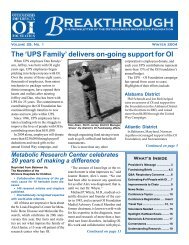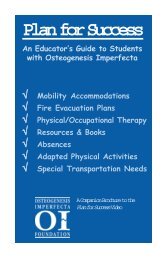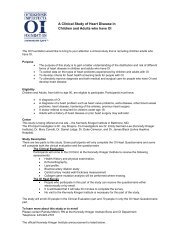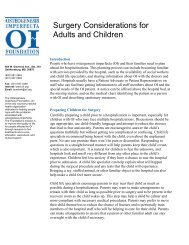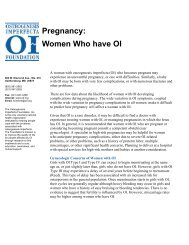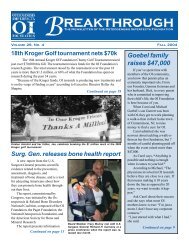National Action Plan for Bone Health - Osteogenesis Imperfecta ...
National Action Plan for Bone Health - Osteogenesis Imperfecta ...
National Action Plan for Bone Health - Osteogenesis Imperfecta ...
Create successful ePaper yourself
Turn your PDF publications into a flip-book with our unique Google optimized e-Paper software.
In addition to adequate screening and diagnosis, there is substantial evidence that<br />
pharmacotherapy <strong>for</strong> appropriate individuals can reduce the risk of fragility fractures. 40<br />
Un<strong>for</strong>tunately, evidence also shows that most individuals at risk do not receive appropriate<br />
therapy. For example, among patients who were hospitalized <strong>for</strong> low-impact fractures<br />
in 2000, only 5 percent were on pharmacologic therapy prior to admission. 41 While<br />
this rose to about 18 percent by 2005, when analyzed 6 months later there was only a 5<br />
percent increase in the number of patients on treatment, and this had not improved during<br />
the 5 years. While we do not have large trials comparing different therapies, there<br />
are differences in efficacy and side-effects among available treatments. 42 Moreover, it is<br />
possible to monitor the response to treatment through bone density measurements and<br />
laboratory studies. The current payer systems may limit both monitoring and flexibility<br />
in the use of different therapies, particularly with the availability of a generic bisphosphonate,<br />
which payers will prefer because of its low cost. It will be important to ensure<br />
that patients have access to the treatments that are best <strong>for</strong> them.<br />
<strong>Bone</strong> health organizations, health care providers, and the public must join advocacy<br />
ef<strong>for</strong>ts to ensure that appropriate reimbursement rates are set <strong>for</strong> evidence-based<br />
practices. Organizations should: increase consumer understanding of access and quality<br />
issues surrounding reimbursement rates, seek more appropriate levels of funding<br />
<strong>for</strong> reimbursement of costs to increase patient access, prevent disincentives <strong>for</strong> use,<br />
and support existing advocacy ef<strong>for</strong>ts. Organizations now lobbying Congress to improve<br />
DXA reimbursement include the Alliance to Protect Patient Access to Osteoporosis<br />
Testing, a partnership of the <strong>National</strong> Osteoporosis Foundation, the International<br />
Society <strong>for</strong> Clinical Densitometry, the Endocrine Society, the American Association of<br />
Clinical Endocrinologists, and the American Society <strong>for</strong> <strong>Bone</strong> and Mineral Research.<br />
Focus on fracture as a sentinel event in bone health management.<br />
Just as a first heart attack is now seen as a sentinel event <strong>for</strong> treating cardiovascular<br />
disease, the first fragility or low-impact fracture must be seen as an intervention<br />
opportunity. According to HEDIS data, osteoporosis management rates (20 percent in<br />
Medicare 2006) are nowhere near the intervention and treatment levels seen <strong>for</strong> other<br />
conditions, such as beta blockers administered post-myocardial infarction (93 percent)<br />
or lipid diagnosis post-cardiovascular event (81 percent). 43<br />
Engaging providers to treat a low-impact fracture as a sentinel event will require<br />
significant provider education, especially <strong>for</strong> emergency room doctors, orthopedists, and<br />
nursing home medical directors and staff, to increase awareness and understanding that<br />
such fractures are a sign that bone disease is present. In addition, hospitals, nursing<br />
homes, emergency departments, and orthopedic practices must develop mechanisms<br />
to capture patients post-fracture, as well as strategies to intervene with appropriate<br />
treatment.<br />
One effective method may be involving a case manager to develop a treatment plan <strong>for</strong><br />
patients who have suffered fragility fractures. The case manager model has been widely<br />
used and studied in the treatment of other chronic diseases, such as heart disease and<br />
diabetes. The case manager, often a nurse, works directly with patients and families<br />
to help them understand the disease, to develop appropriate treatment plans, and to<br />
monitor patient adherence. In one study of the effectiveness of using case managers<br />
<strong>for</strong> osteoporotic fractures, a case manager spoke with patients hospitalized <strong>for</strong> a hip<br />
fracture and arranged <strong>for</strong> BMD testing. The case manager explained the test results to<br />
<strong>National</strong> <strong>Action</strong> <strong>Plan</strong> <strong>for</strong> <strong>Bone</strong> <strong>Health</strong>:<br />
Recommendations from the Summit <strong>for</strong> a <strong>National</strong> <strong>Action</strong> <strong>Plan</strong> <strong>for</strong> <strong>Bone</strong> <strong>Health</strong><br />
23



